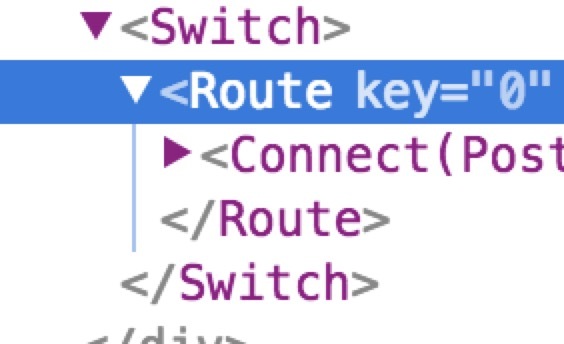您好,登录后才能下订单哦!
这篇文章主要介绍了React-router v4路由配置的示例分析,具有一定借鉴价值,感兴趣的朋友可以参考下,希望大家阅读完这篇文章之后大有收获,下面让小编带着大家一起了解一下。
一. Switch 、Router 、Route三者的区别
1、Route
Route 是建立location 和 ui的最直接联系
2、Router
react-router v4 中,Router被拆分成了StaticRouter、MemoryRouter、BrowserRouter、HashRouter、NativeRouter。
MemoryRouter、BrowserRouter、HashRouter 等于
import { Router } from 'react-router'
<!--这里可以有三种-->
<!--history 部分源码
exports.createBrowserHistory = _createBrowserHistory3.default;
exports.createHashHistory = _createHashHistory3.default;
exports.createMemoryHistory = _createMemoryHistory3.default;
-->
import createBrowserHistory from 'history/createBrowserHistory'
//
const history = createBrowserHistory()
<Router history={history}>
<App/>
</Router>NativeRouter(给rn使用的)
A <Router> for iOS and Android apps built using React Native.
这里新增strict 和 exact
使用了strict location 大于等于path才能匹配,eq path='/one' location='/one/a'能匹配。
使用了exact location 约等于 path 才能匹配,eq path='/one' location='/one'或者 '/one/'能匹配,所以说是约等于。
使用了exact 和 strict location = path才能匹配
StaticRouter(后续补充)
3、Switch
这是v4版本中新添加,主要用来做唯一匹配的功能。就是想要在众多路由中只匹配其中一个路由。
二、v4 版本中路由应该如何配置呢?
1.基本配置(这个和v3中基本一致,效果也基本一样)
匹配 <= location eq.( /b => / + /b ) ( / => / )
<BrowserRouter forceRefresh={!supportsHistory} keyLength={12}>
<div>
<Route path="/" component={aContainer} />
<Route path="/b" component={bContainer} />
</div>
</BrowserRouter>2.含Switch 配置
匹配 <= location eq.( /b => /b ) ( / => / ) 唯一匹配
<BrowserRouter forceRefresh={!supportsHistory} keyLength={12}>
<Switch>
//这里用exact,仅仅是担心location被 path='/'截胡了。
<Route exact path="/" component={aContainer} />
<Route path="/b" component={bContainer} />
</Switch>
</BrowserRouter>问题(三个问题)
1.如何设置公共的Component
第一种方式
<BrowserRouter forceRefresh={!supportsHistory} keyLength={12}>
<div>
<Route path="/" component={aContainer} />
<Route path="/b" component={bContainer} />
</div>
</BrowserRouter>第二种方式(父子嵌套)
<BrowserRouter forceRefresh={!supportsHistory} keyLength={12}>
<div >
<Route path="/" component={aContainer} />
<Route path="/b" component={Parent} />
{/* {app()} */}
</div>
</BrowserRouter>const Parent = ({ match }) => (
<div>
<Route path={`${match.url}/`} component={bContainer} />
<Route path={`${match.url}/c`} component={cContainer} />
<Route path={`${match.url}/d`} component={dContainer} />
</div>
);这种情况 bContainer就是是公用的Component
2.如何设置getComponent,按需加载
另一篇文章
3.是否有简化写法
npm install --save react-router-config
第一步 配置路由
const routes = [
{ component: bContainer,
routes: [
{ path: '/',
exact: true,
component: bContainer
},
{ path: '/b/b',
component: bContainer,
routes: [
{ path: '/b/b/b',
component: bContainer
}
]
}
]
}
]第二步 设置路由
<BrowserRouter forceRefresh={!supportsHistory} keyLength={12}>
<div >
{renderRoutes(routes)}
</div>
</BrowserRouter>第三步 需要在container的render中去调用方法
<div>
1111
{renderRoutes(this.props.route.routes)}
</div>这个优势是可以统一配置,劣势是需要在container中统一调用,但是这个抽出来统一实现,问题也不大,并且还可以解决 问题一。
这个renderRoutes实际是就是用一层Switch和多个Route来包了一层。

感谢你能够认真阅读完这篇文章,希望小编分享的“React-router v4路由配置的示例分析”这篇文章对大家有帮助,同时也希望大家多多支持亿速云,关注亿速云行业资讯频道,更多相关知识等着你来学习!
免责声明:本站发布的内容(图片、视频和文字)以原创、转载和分享为主,文章观点不代表本网站立场,如果涉及侵权请联系站长邮箱:is@yisu.com进行举报,并提供相关证据,一经查实,将立刻删除涉嫌侵权内容。